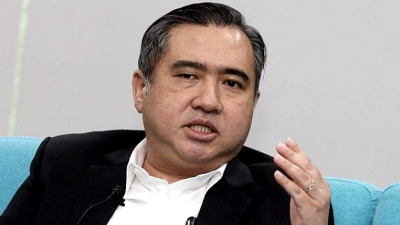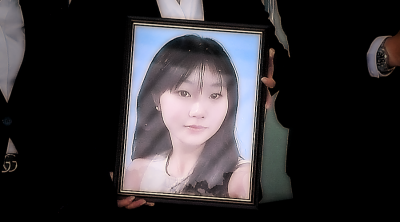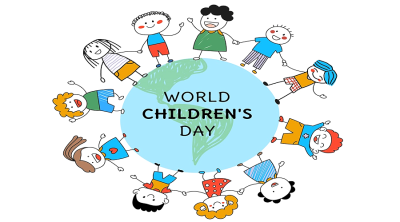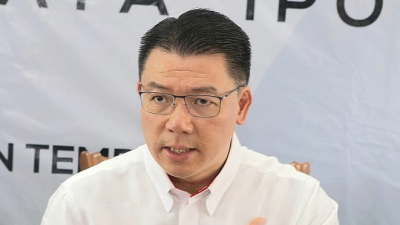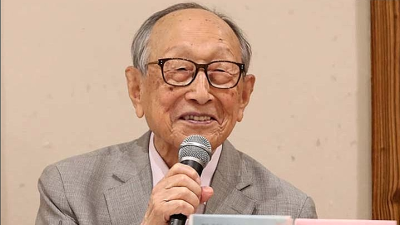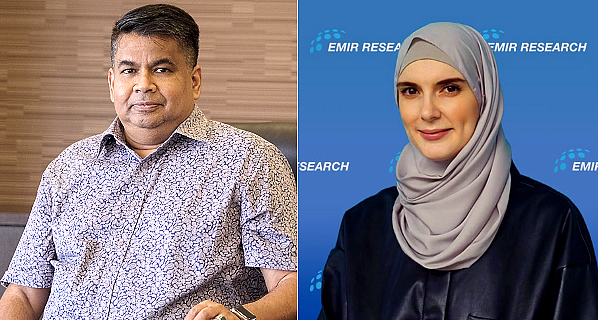
The ambitious political goal of building a competitive national economy, set by the leaders of many countries, including Malaysia, in 4IR reality, where knowledge becomes the key factor of industrial progress, requires highly accentuated attention to the education sector as a true engine room of future national prosperity and the pipeline of economic miracles.
While Malaysia’s Education Blueprint 2013-2025, in its opening pages, proudly boosts its higher spending on education among the regional peers, those same peers, together with other top-education nations, significantly overtake it in terms of national educational outcomes and economic and well-being impacts (Figure 1).
Meanwhile, Malaysia as remained so remains in the lower tiers of international performance test results such as PISA and TIMSS.
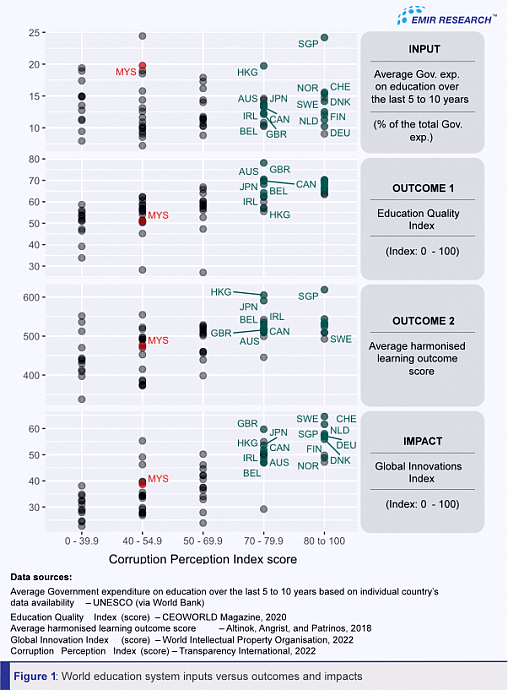
It is always an insightful exercise to look at the international laboratory for the common trends among highly successful national education systems.
According to various global education indices, opinion-based measures (global surveys) and international test scores, countries that consistently appear on the top of the list are Australia, Belgium, Canada, China, Denmark, Finland, Germany, Hong Kong, Ireland, Japan, Netherlands, Norway, Singapore, South Korea, Sweden, Switzerland, Taiwan, United Kingdom (England) and United States.
Other countries that either made their appearance on top of some of these charts or made spectacular progress over the last years and, therefore, worth looking at are Estonia, France, Iceland, Israel, Kazakhstan, Lithuania, Luxembourg, New Zealand, Poland, Portugal, Russia, Slovenia, Vietnam and the United Arab Emirates.
While analyzing their educational policies, it is difficult not to notice remarkable similarities.
Although, admittedly, it is difficult to replicate successful education system models because they are firmly nested within the system of national culture and mentality, and every successful national education system is, rightfully, a successfully stumbled-upon phenomenon.
In fact, building a character as opposed to individual characters as an integral part of national educational efforts is the first tall similarity among the top-education countries.
Broader education
Interestingly, the top-education countries have solid cultural and moral values where “if you go into society, you go by the rules”. And as a result, these countries spend considerable time and effort to inculcate those rules, values, morals, practical and social skills, positive personality traits, interests, humane attitude to the environment and the whole range of things beyond reading, math and science essential to achieve social harmony and prosperity.
These countries mold the change they want in society from a very early age and, notably, not just through some abstract teachings and class discussions but via realignment of the teaching methods themselves.
For example, everyone knows there is no cleaning staff in Japanese schools — students take care of the order in the classrooms, corridors and toilets on their own.
And, contrary to the standard approach of calling the strongest student to the board, in a Japanese school, the weakest students would be invited while the whole class would collectively help them if needed. This is because discipline and a sense of collectivism are two pillars of the Japanese education system.
Educational equity
In the top-education countries, there are almost no private schools (or any lists of “best schools”) because they are not needed, given the government’s solid commitment to providing free education of the highest quality to all children irrespective of their ethnicity, location (urban/rural) or size of their parents’ pay checks!
Achieving equitably shared prosperity for the nation is simply impossible with an unequal and highly segregated national education system.
Therefore, top-education nations either get rid of or significantly postpone until older age the selection into different schools, selection into different classes or tracks within a school based on performance and/or for individual subjects (e.g. Belgium, Denmark, Finland, Japan, Netherlands, New Zealand, Norway, Singapore etc.).
With ample empirical evidence, these segregation practices disadvantage students from lower socioeconomic backgrounds and maintain and deepen regional, social and gender inequality.
Meanwhile, postponing or eliminating such segregation was found to have, at least, no negative impact on the overall performance!
Some top-education nations made private schools part of this system by funding them and prohibiting them from charging fees or selecting students based on abilities! There are also heavy incentives for teachers to take rural hardship postings.
Support for early childhood education
Access to high-quality early childhood education is empirically related to better intellectual and social development and is found to be particularly beneficial to children from the most disadvantaged backgrounds (e.g. The Effective Provision of Pre-School Education Project).
This is not surprising, as neurological and social studies have shown that most brain (90%) and neural pathways (85%) growth occurs during the first five years of life.
Therefore, among the top-performing educational systems worldwide, subsidizing early education by the government (e.g. Canada, Denmark, Finland, Germany, New Zealand, Norway, South Korea, United Kingdom), support of the private sector by providing facilities for childcare (e.g. the United States) and reducing the age of compulsory education (e.g. Belgium, Netherlands, Switzerland) unanimously is given great attention.
Focus on exact sciences and languages
Science is the engine of economic growth, while the English language, in modern days, is the language of science.
Therefore top countries with excellent educational achievements have near cult reverence about exact science subjects and ensure that all the students, starting from an early age, are highly fluent in multiple languages (spoken in their land or a language of choice), including English.
This is not a matter of nationalism but economic competency for the nation!
Focus on higher bloom’s taxonomy skills
The higher levels of Bloom’s taxonomy, the model used for classifying educational learning objectives into layers of complexity and specificity, are about knowledge synthesis and new knowledge creation — precisely where top-education nations spend most of their educational efforts.
Such nations as Denmark, Finland, Japan, Singapore, Estonia, and even China have fast moved away from rote learning and regurgitating primitive ideas towards scientific attitudes, technological progress and progressive teaching and assessment methods.
While some Islamic countries may shy away from studying philosophy, top-education nations find it to be a crucial subject to develop a critical, reasoning mind and ability to think on the level of bigger concepts and ideas.
The top-education nations also place great emphasis on students’ ability to articulate and devise different strategies, ability to work independently with information, the ability to integrate knowledge in various fields to solve a specific problem (phenomenon-based learning) and research skills — all of these even for the most junior school years and, as we already know, in multiple languages!
High professional standards and social status of teachers
A student’s success depends primarily on the impactful teachers they meet on their academic voyage. This is why one common trend among the top-education nations is that a teacher is a highly respected, highly paid job requiring one of the highest qualifications in those countries.
Teaching cannot be simply subcontracted to those who could not find placement elsewhere in the industry.
Among the top-education nations, at least a Master’s degree is a common requirement for a teacher in a school at all levels in an attempt to bring more science to pedagogical practice! Furthermore, these nations place the most qualified teachers at pre- and primary schools!
For example, in Finland, becoming a teacher is more challenging than becoming a medical doctor. Germany, Japan, Netherlands, Singapore, and Switzerland are a few other countries where pedagogy is as serious field as medicine or law.
High teacher/school autonomy with great accountability
It is important to note that this is rather an extension of the previous common trend.
Because in the top-education nations, teachers at all levels are highly-learned professionals who bring science to pedagogical practice, they enjoy greater freedom to innovate and experiment with new teaching methods. In many top-education countries, the teaching profession is one of the most creative and free.
Likewise, in most top-education countries, an extensive degree of autonomy is granted to individual schools but with the accountability to demonstrate specific outcomes and impacts.
The government sets minimum attainment targets that specify the knowledge, skills and attitudes students should demonstrate by the end.
Continuous dynamic exchange of best practices
As highly professional teachers given the freedom to be entrepreneurial and experimental about their teaching methods based on data and science, the tools and methodologies proven to deliver results should be immediately promulgated throughout the entire education system.
For example, Belgium, Denmark, Finland, Japan, United Kingdom are countries with highly collaborative education systems among the teachers or schools and with a great number of incentives from the government for dynamic exchange activities.
Individual attention to every student
The top-education nations understand that giving timely attention to each student is not as costly as it can become if the student falls behind and later is excluded from an active and the most productive socioeconomic life—more enormous loss and cost to the government.
Therefore, one common trend among top-education countries is a more favorable teacher-student ratio, a student-centered approach aimed at detecting individual capabilities and talents, and extra support for each student.
As we already learned, in these countries, students are not segregated based on performance.
However, individual attention is given on-spot in the class, as a problem arises to minimize the gap between strong and weak students.
The above global educational trends are summarized graphically in Figure 2.

Malaysia has already lost at least one decade to keep up with the above trends.
Already in 2009, World Bank, based on its surveys, reported a severe shortage of high technical skills in Malaysia, including among the fresh graduates, reflecting serious problems within the education system.
Consistently, in the latest World Bank report on Malaysia from 2021 titled Aiming High: Navigating the next stage of Malaysia’s Development, the need to create high-skilled jobs and talents was again underscored simply in every second paragraph of this report.
It is time for Malaysia to put the spirit into saying that tomorrow belongs to those who prepare for it today by keeping up with the best educational practices.
(Dr. Rais Hussin and Dr. Margarita Peredaryenko are part of the research team at EMIR Research, an independent think tank focused on strategic policy recommendations based on rigorous research.)
ADVERTISEMENT
ADVERTISEMENT








